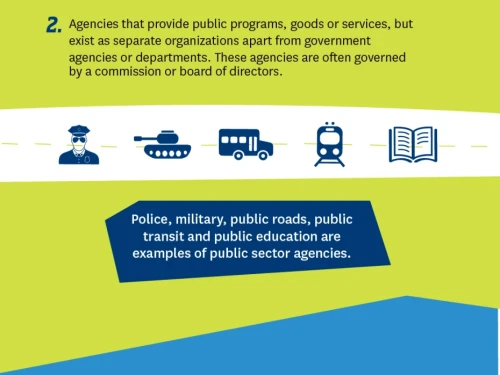Public Administration
Kent State’s Master of Public Administration program equips future leaders with the skills to drive meaningful change in public, nonprofit, and private sectors. Her, dive into topics like policy development, nonprofit management, and public service leadership while exploring career pathways and insights into the evolving field of public administration. With NASPAA accreditation and a focus on practical impact, Kent State prepares graduates to excel in roles that shape communities and governance.
Related Blog Posts
The nonprofit sector plays a vital role in addressing societal challenges, promoting social justice, and improving communities. However, leading a nonprofit organization requires a unique blend of leadership, financial acumen, and strategic thinking. Whether you aspire to lead a charitable organization, community program, or advocacy group, earning an online Master of Public Administration (MPA) can equip you with the skills and knowledge needed to navigate the complexities of nonprofit management successfully.
Balancing work, family, and personal commitments while pursuing a graduate degree can feel overwhelming for professionals looking to advance their careers in public service. However, with Kent State University’s 100% online Master of Public Administration (MPA) program, achieving your career goals is not only possible but also convenient and flexible.
In today’s complex and evolving landscape, public service professionals are needed more than ever to address societal challenges, shape policies, and lead organizations that serve communities effectively. Whether your passion lies in government, nonprofit management, or the private sector with a focus on public service, a Master of Public Administration (MPA) can be your key to unlocking a wide range of leadership opportunities.
Public service is a broad field that encompasses both government agencies and nonprofit organizations, each playing a crucial role in addressing societal needs and improving communities. Although both sectors aim to serve the public good, they operate under distinct models that shape their impact and leadership challenges.
Kent State University’s Online Master’s in Public Administration has moved up in the U.S. News rankings! The program is currently ranked 135 (out of 270) in the U.S. News 2024 Best Public Affairs Programs. The program is also tied for 4th place in Ohio and second place in Northeast Ohio.
Watch Dr. Daniel Hawes speak to Sage Publications about a paper he presented at the American Political Science Association conference in Montreal 2022. The paper also won the Herbert Kaufman Best Paper award from the Public Administration Section in 2023.
A Master of Public Administration career, and others in the nonprofit sector, present incredible opportunities to identify specific needs in a community and find ways to solve them.
There are many reasons to choose to pursue a career in the public sector rather than in the business world. Often, people are drawn to public or nonprofit careers because doing so gives them an opportunity to do good and enact change for the better.
Pursuing a graduate degree usually means a big payoff for your future but it can feel counterintuitive to take off a whole year or two from your career. That’s where part-time degree programs come in. Earning your degree as a part-time student means you can continue to work while you gain relevant skills to move your public sector career forward. But there’s more to it than just avoiding a break in your resume.
When you think of nonprofits, what organizations first come to mind? You might initially think of Doctors Without Borders, the Bill and Melinda Gates Foundation, the Red Cross or UNICEF. According to the United States Internal Revenue Service (IRS), nonprofit organizations include any organization that is not organized or operated for the benefit of private interests, and does not promise any net holdings to the benefit of any private shareholders or individuals.1
If you’re looking for a graduate degree that could help you on your way to establishing yourself as a leader in a compelling field, have you looked into the Master of Public Administration (MPA)? While it might not be as common as its private sector counterpart, the Master of Business Administration (MBA), it can help you build comparable skills for leadership in nonprofit organizations, the government as well as many for-profit businesses.
Grad school can open a world of opportunities. It’s wise to do your research and make sure you’re pursuing the right degree and program to reach your career goals. People interested in strengthening skills to head an organization might need to make a decision between more than one degree, specifically: a Master of Public Administration (MPA) or Master of Business Administration (MBA).
As with jobs in all industries, jobs in the public sector have certain advantages and disadvantages. While each person might have their own opinion of what constitutes a positive or negative aspect of any career, read on for our take on the pros and cons of working in the public sector.
Get to know Kent State University even more through our vast array of blogs.
If recent newspaper headlines are to be believed, many people are wondering if the U.S. government is getting too large. While it’s true that over 15% of the workforce is involved in the military, public and national service, the size of the U.S. government proportionate to the total population has actually shrunk in the last 50 years. Beyond that, we’re facing an aging government workforce, of which one third will be eligible to retire by 2025.1
COVID-19 has disrupted every facet of life, especially the working lives of countless people across the globe. National and statewide lockdowns have caused mass shutdowns, layoffs and furloughs. There have been upheavals in work schedules, changes in work locations and often simultaneous struggles to meet children’s educational needs at home. Dealing with this strange new reality has been challenging, to say the least. Across the public and private sectors, organizations have scrambled to navigate chaotic work environments. Stepping out of back offices and into center spotlights, the leaders of human resources management are transforming HR, rising to meet the new and pressing needs of today’s disrupted workforces.
Public sector government agencies are present in every city and town around the world, with employees undertaking a wide variety of projects aimed at improving their local community. These involve things like health and safety, transport infrastructure, parks and recreation, sewage and water, schools, hospitals and municipal buildings. As a public service, these agencies rely on government funding and, in many cases, don’t have access to the same high budgets that private sector companies have.
Before you commit to an advanced degree such as a master’s of public administration, it’s important to consider whether it will be worth the investment of your time and money. For some people, an MPA program can be a life-changing experience that prepares them for professional success and greater personal fulfillment. For others, an MPA may not be the right choice.
It’s easy to think of technology as flashy and fun: the newest TikTok video, the latest virtual background, the most thrilling special effects. Though we may not realize it, technology also plays an enormous role in the progress and achievements of the public sector.
As noted elsewhere on this site, “Broadly speaking, the public sector refers to any part of a state or national economy that is tied to public programs or services and is controlled by the government.” You may find public sector employment opportunities in the military, law enforcement, organizations managing infrastructure (public roads, bridges, tunnels, water supply, sewers, electrical grids, telecommunications, and so on), departments of public transit or public education, and in healthcare and the government itself.
Many companies hire MPA graduates knowing that the skills they’ve acquired are as valuable in the for-profit sector as they are in the government and not-for-profit worlds. Among the many companies likely to hire MPA graduates, these 10 stand out.
When you think of “public administration,” you may envision managing budgets for a city transportation department or improving the efficiency of a town’s public health division. But for graduates with a master’s degree in public administration, there are many career possibilities that might not come to mind right away. A public administrator plans, organizes, directs, coordinates and controls operations in a government office, private company or nonprofit organization. This can be in positions as diverse as that of a community health director or the budget director at an environmental justice nonprofit. An MPA opens a world of opportunities.
Careers in government and public administration often attracts idealistic people who want to make a difference in our democracy and in the lives of their fellow citizens. But what does it actually take to become a leader in bureaucratic structures at the municipal, state and federal levels?
There are many reasons to choose to pursue a career in the public sector rather than in the business world. Often, people are drawn to public or nonprofit careers because doing so gives them an opportunity to do good and enact change for the better, rather than just increasing profits for a corporation. But even if you know you want to work in government or at a nonprofit organization, the exact path you follow can vary greatly.
If you enjoy leading others, improving systems, overcoming complex challenges and helping shape the direction of a business or organization, you might be a good candidate for the role of director of administration.
“What does a public administration salary look like?” The path to public good is a personal one, but odds are nearly every person entering the field wonders what kind of salary they can expect. When you think about public administration your mind may automatically drift toward thoughts of government and nonprofit roles, but there are lucrative roles in the private sector as well. What you do with your degree and experience is entirely up to you. You could find roles in government service, nonprofit organizations, or the private and public sectors. Below, we’ll explore roles in each of these categories and discuss the potential public administration salaries for various careers.
If you’re ambitious, interested in municipal government and hoping to make change in your local community from the top down, the role of city manager may be the perfect career goal for you. It’s an excellent choice for well-organized, diplomacy-minded professionals in public administration.
When life feels unpredictable, most people want a plan for certainty. That’s especially true when it comes to making decisions about careers and weighing the pros and cons of graduate school. While no crystal ball will predict exactly what jobs will exist in the global economy in the years and decades ahead, authorities suggest that lifelong learners will have the advantage in getting hired and promoted.
One of the best things about working in the public sector is that it gives you many ways to make a difference in your community, no matter what role you fill. You can be confident that you’ll be part of an organization or government body that has the power to change the world (or at least your community) for the better.
In the world of public administration, there are frequent references to the “public sector.” But what exactly is the public sector? And why does it require such careful attention and monitoring by public officials? Broadly speaking, the public sector refers to any part of a state or national economy that is tied to public programs or services and is controlled by the government.






























